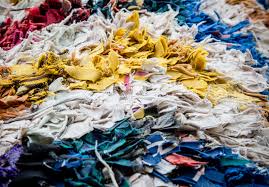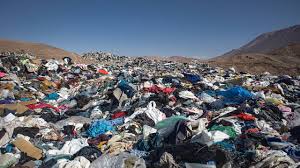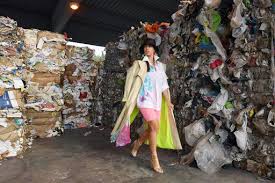Fiber wastes in the fashion industry are leftover or discarded materials made from fabrics like cotton, wool, or polyester. These materials are usually thrown away or not used, contributing to environmental problems.
In the glittering world of fashion, where trends change as swiftly as the seasons, there exists a not-so-glamorous secret – fiber waste. This issue, often overlooked, has far-reaching consequences for our planet and our closets.
Simply put, fiber waste refers to the bits and pieces of fabric that are left unused or discarded during the clothing production process. These are the scraps and remnants of textiles like cotton, silk, wool, and synthetic materials such as polyester. Think of them as the trimmings from a tailor’s workshop or the scraps from your grandma’s quilting projects.
Why Does It Matter?
1. Environmental Impact: The fashion industry is notorious for its environmental footprint. Fiber waste adds to this burden by increasing the demand for raw materials. The more we waste, the more we need to produce, which leads to deforestation, water pollution, and greenhouse gas emissions.
2. Economic Loss: Fiber waste also hits the fashion industry’s wallet. It’s like throwing money away. Fabric is expensive, and when we discard it, we’re squandering resources and driving up costs.
3. Missed Opportunities: Those bits of leftover fabric hold untapped potential. They could be repurposed, upcycled, or recycled into new garments and products. This not only reduces waste but also offers innovative avenues for creativity.
Solutions
The good news is that many in the fashion industry are waking up to the problem of fiber waste and seeking solutions:
1. Design for Efficiency: Fashion designers are rethinking their creative process, aiming to generate less waste from the start. This means designing patterns that utilize fabric more efficiently.
2. Recycling and Upcycling: Recycling old clothing and using fiber waste to create new textiles is on the rise. Brands are turning scraps into stylish accessories or even new fabrics.
3. Consumer Awareness: As consumers, we have a role to play too. By choosing brands that prioritize sustainability and reduce waste, we can influence the industry’s direction.
Fiber waste might not be a glamorous topic, but it’s a crucial one. It represents an opportunity for the fashion industry to reshape its practices, reduce its environmental impact, and make the world a more stylish, sustainable place. The next time you slip into a new outfit, remember the story behind the scraps – and how they’re changing the face of fashion.
Read Also: What You Need to know about Tire Waste
The Significance of Fiber Waste in Fashion

In the dazzling world of fashion, fiber waste might not grab the headlines, but its role is paramount. Let’s explore why paying attention to fiber waste is of utmost importance in the fashion industry.
1. Preserving Resources: Every piece of fabric that goes unused or ends up as waste represents a loss of valuable resources. Fabrics like cotton, silk, and polyester require significant raw materials and energy for production. By minimizing fiber waste, the fashion industry can help conserve these precious resources.
2. Reducing Environmental Impact: Fashion, as we know it, has a substantial environmental footprint. Excess fiber waste exacerbates this problem by leading to increased demand for raw materials. This, in turn, contributes to issues like deforestation, water pollution, and greenhouse gas emissions. Addressing fiber waste is a crucial step in reducing the industry’s impact on the environment.
3. Economic Efficiency: Wasting fabric means wasting money. When fashion brands discard sizable portions of materials, it inflates production costs, which can eventually trickle down to consumers. By curbing fiber waste, the fashion industry can improve its economic efficiency and potentially offer more affordable and sustainable products.
4. Encouraging Innovation: Fiber waste isn’t just a problem; it’s an opportunity for innovation. Designers and brands are increasingly finding creative ways to repurpose these discarded materials. From upcycled accessories to entirely new fabric blends, addressing fiber waste fosters innovation and opens up exciting avenues for fashion creativity.
5. Consumer Influence: Consumers hold substantial influence in shaping the fashion industry. By supporting brands that prioritize waste reduction and sustainability, shoppers can encourage positive changes. Your choices as a consumer can drive fashion companies to take meaningful steps toward reducing fiber waste.
Fiber waste might be hidden from the glamorous runway lights, but its importance in the fashion industry cannot be understated. It’s about preserving resources, reducing environmental harm, improving economic efficiency, fostering innovation, and allowing consumers to make a positive impact. By acknowledging and addressing fiber waste, the fashion industry can evolve into a more responsible and sustainable force for style and change.
Read Also: TV Recycling Process Complete Guide
Creative Solutions for Tackling Fiber Waste

In the world of fashion, where style meets sustainability, a quiet revolution is brewing. It’s all about reimagining what we do with those leftover fabric bits and scraps, the fashion industry’s unsung heroes. Let’s explore some fresh and innovative ideas to transform fashion fiber waste into something extraordinary.
1. Zero-Waste Design: Imagine fashion designers as puzzle masters. Zero-waste design is like putting together a stylish puzzle with no leftover pieces. It involves creating clothing patterns that use every bit of fabric, leaving no scraps behind. Designers are embracing this challenge, crafting garments that not only look fabulous but also conserve resources.
2. Fiber Recycling Magic: What if we could breathe new life into old clothes and fabric scraps? That’s the magic of fiber recycling. Fashion brands are investing in technology that transforms discarded textiles into fresh, high-quality materials. These recycled fibers can be used to make new clothing, reducing the need for virgin resources.
3. Upcycling Unleashed: Upcycling is like fashion’s artful remix. Instead of tossing unused fabric bits, designers and DIY enthusiasts are upcycling them into unique, one-of-a-kind pieces. From patchwork jeans to funky accessories, upcycled fashion is all about turning “waste” into wearable art.
4. Sustainable Accessories: Accessories are the spice of fashion, and they’re ripe for a sustainable makeover. Fashionistas are now creating stylish accessories from fiber waste. Think handbags made from old denim or jewelry crafted from fabric scraps. It’s a chic way to repurpose and reduce waste.
5. Collaborative Creativity: The fashion industry is recognizing the power of collaboration. Brands are teaming up with environmental organizations, artists, and communities to find new ways to address fiber waste. This collective effort sparks fresh ideas and innovative projects.
6. Consumer Empowerment: As consumers, we hold the key to change. By choosing fashion brands that prioritize sustainability and waste reduction, we can drive the industry in the right direction. Our choices influence the way fashion is made and how fiber waste is managed.
Fashion fiber waste is no longer a problem without solutions. It’s an opportunity for the fashion industry to shine with creativity, innovation, and sustainability. With zero-waste design, fiber recycling, upcycled fashion, and collaborative efforts, fashion is transforming into a force for positive change. So, the next time you wear a stylish, eco-friendly piece, remember that fashion’s future is built on fresh ideas for managing fiber waste.
Read Also: Products That Can Be Made From Cocoa

